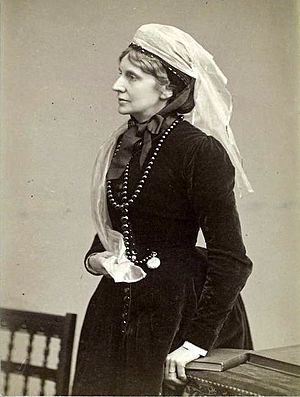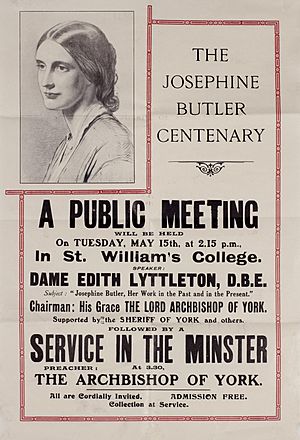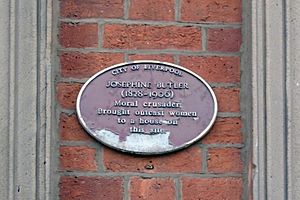Josephine Butler facts for kids
Quick facts for kids
Josephine Butler
|
|
|---|---|
 |
|
| Born |
Josephine Elizabeth Grey
13 April 1828 Milfield, Northumberland, England, UK
|
| Died | 30 December 1906 (aged 78) England, UK
|
| Cause of death | Natural death |
| Nationality | British |
| Occupation | Social worker |
| Years active | 1869–1886 |
| Known for | Victorian feminist Contagious Diseases Acts |
| Spouse(s) | George Butler (m. 1852 – 1890 [his death]) |
| Children | George Butler Arthur Charles Butler Charles Augustin Vaughan Butler Evangeline Mary Butler (1859–1864) |
| Parent(s) | John Grey (1785–1868) Hannah Eliza Annett (1792 – 15 May 1860) |
Josephine Elizabeth Butler (née Grey; born April 13, 1828 – died December 30, 1906) was an English feminist and social reformer. She lived during the Victorian era, a time when Queen Victoria ruled Britain. Josephine worked hard to change unfair laws and help people.
She fought for many important rights. These included the right for women to vote. She also wanted women to have better education. Josephine worked to end old laws that treated women unfairly. She also campaigned against child abuse and human trafficking.
Contents
Josephine Butler: A Champion for Change
Josephine Grey grew up in a family that believed in progress. They were also connected to politics. This helped her develop a strong sense of right and wrong. She also had deep religious beliefs.
She married George Butler in 1852. He was a teacher and a church leader. They had four children together. Their youngest child, Eva, sadly died in an accident. This sad event changed Josephine's life. She decided to use her feelings to help others. She started by helping people in a local workhouse.
Fighting for Women's Rights
Josephine began to campaign for women's rights. She wanted to change British laws. In 1869, she joined a big campaign. This campaign aimed to get rid of the Contagious Diseases Acts. These acts were very unfair to women.
Josephine and her supporters worked for many years. Their hard work paid off in 1886. The unfair laws were finally removed. Josephine also started a group called the International Abolitionist Federation. This group worked across Europe. It aimed to fight similar unfair systems in other countries.
Her Legacy and Recognition
Josephine Butler was a very busy writer. She wrote over 90 books and pamphlets. Most of these writings supported her campaigns. Her ideas about Christian feminism are still remembered today.
The Church of England celebrates her with a special day. You can also see her in stained glass windows. These are in Liverpool's Anglican Cathedral and St Olave's Church in London.
Her name is on the Reformers Memorial in London. Durham University also named one of their colleges after her. Her ways of campaigning changed how feminists fought for rights in the future. After she died in 1906, a famous feminist, Millicent Fawcett, called her "the most distinguished Englishwoman of the nineteenth century."
Later Life and Passing
From 1901, Josephine Butler started to step back from public life. She left her roles in the campaign groups. She spent more time with her family. In 1903, she moved to Wooler in Northumberland. She wanted to live closer to her oldest son.
Josephine Butler passed away at home on December 30, 1906. She was buried in the nearby village of Kirknewton.
In 1907, her name was added to the Reformers' Memorial. This memorial is in Kensal Green Cemetery, London. It honors people who "defied custom and interest for the sake of conscience and public good." She is remembered on May 30 by the Church of England. Her image is also in stained glass windows. These are in Liverpool's Anglican Cathedral, All Saints' Church, Cambridge and St Olave's Church in London.
Images for kids
-
Bust of Butler in 1865, aged 36, by Alexander Munro
-
The Home Secretary, Henry Bruce, who set up a Royal Commission in 1871 to examine the Contagious Diseases Acts
-
William Gladstone, a friend of the Butlers, and a tacit supporter of Butler's work
-
Butler in old age, by George Frederic Watts, 1894
See also
 In Spanish: Josephine Butler para niños
In Spanish: Josephine Butler para niños













